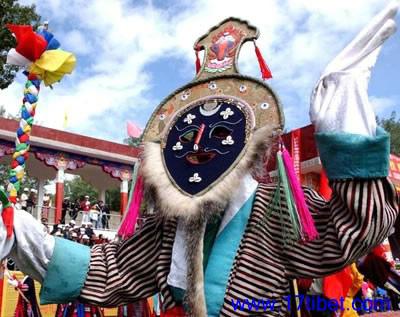Tibetan Play
2009-08-10 17:35 BJT
Tibetan play is an important cultural component of Tibetans' social life. Called "Ace Lhamo" in Tibetan, it is very popular in Tibet, Sichuan, Qinghai and Yunnan Provinces where many Tibetans live. This art form carries strong flavors of Tibetan Buddhism in expression techniques and contents. As an extensive dramatic system, Tibetan play incorporates many types and schools of art due to different natural conditions, customs, culture and traditions, as well as dialects on the Qinghai-Tibet Plateau. The Tibetan play in Tibet is the precursor of Tibetan play. Spread to Tibetan areas in Qinghai, Gansu, Sichuan and Yunnan by monks and pilgrims that pursue further training in temples in Tibet, Tibetan play developed into many branches, such as Huangnan Tibetan play of Qinghai, Gannan Tibetan play of Gansu, and Seda Tibetan play of Sichuan. Tibetan play is also popular in Tibetan-inhabited areas in India, Bhutan and Sikkim, etc.
 |
| Tibetan play is an important cultural component of Tibetans' social life. |
Tibetan play is a comprehensive art of performance that tells stories through folk songs and dances. It is said that in the 15th century, a hierarch named Thangthong Gyalpo from the Kagyu School aspired to build bridges across all rivers on the snow-capped plateau for public benefits. Despite his painstaking efforts to raise funds for over three years, he still could not make his dream come true. Later, he organized a drama troupe of seven bright and pretty girls that were adept at singing and dancing from devout followers of the school, and instructed them to play the song and dance dramas with simple plots that he had compiled on the basis of Buddhist stories. The drama troupe toured different places to moralize people and raise funds. This was the rudiment of Tibetan play.
Then, Thangthong Gyalpo was regarded as the founder of Tibetan play, and because of the seven attractive and fairly-like performers, Tibetan play assumed the name "Ace Lhamo" in Tibetan where "Ace" means girl or woman and "Lhamo" means fairy. Of course, with adornment, enrichment and enhancement by several generations of folk artists, Tibetan play is no longer what it used to be. In the 17th century, Tibetan play separated from religious rituals, and gradually developed into a life-based performance form which centers on singing, and combines basic patterns of songs, chants, dances, narration and stunts.
Editor: Zhang Wen | Source: Cultural China
 Mail
Mail Share
Share Print
Print


 Video
Video









 2009 China Central Television. All Rights Reserved
2009 China Central Television. All Rights Reserved